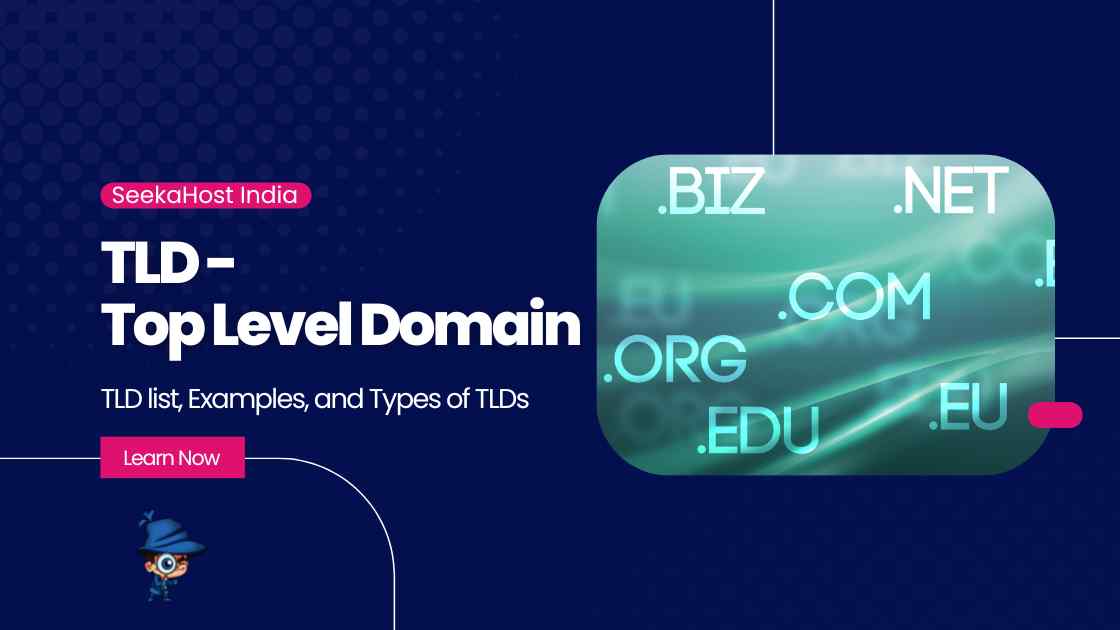
What is TLD? – Top Level Domains List, Example, Types of TLDs

By Aslam | June 28, 2024
People look at the website with different perspectives based on their tastes, needs, or how business magnets want them to look or like, or even to the point that only what they choose only what consumers must see and purchase even if it doesn’t cover under their bucket list or needs. With that in mind, TLD (top level domain) also makes a huge impact on the consumer’s attraction that decides the types of audience with just dot names come along with the end of the domain name.
Don’t make confuse yourself with this topic. We will decode the old decade definition and further related topics covered under it.
What is Domain Name?
A simple brief. A powerful name that will make you stand out on the huge crowd of websites or businesses online. Like how people remember your name because of your good deed, people will remember your business or website with the name you give it.
They also use that name to search on the browser to find your website or business or any related terms you use on the website and its pages.
READ MORE on What is Domain Name and How Does it work?
What is TLD?
TLD Full Form – Top Level Domain. TLDs serve to recognize certain elements of a website, such as its purpose, owner, or geographical area. For example, .edu helps you to identify that, it’s a website used for an educational institute or any educational purpose. TLD is also called Domain Extension.
Building a country-based website, it has “ccTLD”. Building world wide website or common purpose has “gTLD”. Building website control or based on government or business organizations has “sTLD”. Building for any testing purpose has “tTLD”.
It has everything you need or want for more than what you think it can do. The only thing you have to do is register the domain name with the right extension that supports both the domain name and defining the website content purpose.
READ: Cheapest Domain TLD List to Register, Transfer, Renewal
Breakdown of Domain Name:
Name – https://www.seekahost.in
(Full name including the TLD)
Protocol – https:// (SSL – Secure Socket Layer protection)
Subdomain – www (It can also be a blog or page like blog.domainname.com if you like to make that searched or identified on the search page as unique. If don’t need you can avoid to include in the domain name.)
Domain name – SeekaHost (Between the subdomain and TLD you’ve to give the name for your website which serves as a full/part name for your website.)
TLD/Top-Level Domain – .in (A ID or Identification of what or how your website is all about including the purpose or content based.)
Top Level Domains List:
We have mentioned a few Top Level domains list, which are the Commonly used TLDs across the globe. Also, it’s obvious that .com is easily the most popular TLD among these.
Types of TLD:
-
gTLD – Generic Top-Level Domain
gTLD – Generic Top Level Domain – These TLDs are considered the common top-level domain and are popularly recognized by people more than other TLDs because they do not even come to know of the other Top Level Domain.
Most recognized among dozens of gTLD are as follows,
- .com
- .net
- .org
- .xyz
- .club
- .biz
- .top
All the TLDs come under the direct guidance and governance of the ICANN which is top of all the registrars. If there is any new Top Level Domain to be introduced under this category, then it will be called “new gTLD”.
ALSO READ: What does the .COM domain represent?
-
sTLD – Sponsored Top Level Domain
sTLD – Sponsored Top Level Domain – You wonder how the government or private sector domains are being purchased and managed unlike we people normally purchase and manage the Top Level Domain(TLD). This category is specifically made for those who have been sponsored by a specific entity or business or government agency.
To register your domain name under this category, then you must abide by the rules they made, unlike the gTLD where you don’t face many instructions or rules placed on them while registering the domain.
Also, it will have only a limited number of TLDs, unlike the gTLD where there will be a pool of options to showcase and choose from if you couldn’t get one TLD.
- .gov – for use by the US government.
- .edu – for post-secondary institutions that are accredited by the US Department of Education.
- .mil – for use by the US military.
However, you’ll also find smaller sTLDs like:
- .museum – reserved for museums.
- .jobs – reserved for human resource managers and sponsored by the Society for Human Resource Management.
- .post – sponsored by the Universal Postal Union.
- .travel – reserved for travel agencies and similar businesses.
ALSO READ: What is Second Level Domain? – SLD and ccSLD
-
ccTLD – Country Code Top-Level Domain:
ccTLD – Country Code Top-Level Domain – This is another category that will give stiff competition to gTLD owners in terms of business in specific countries. Because when people search globally, they get the gTLD mostly suggested on the first page. But what if people need or search for based on the country’s preference or product or content? Then they will go for the only country-based websites to trust and get the result so that they can manage things under their belt and understand better on the topic.
Here are some examples of ccTLDs available:
- .in– India
- .uk – United Kingdom
- .us– The United States of America
- .va– Vatican city state
- .cn– China
- .ke– Kenya
- .eg– Egypt
- .भारत– India
- .台湾– Taiwan
- .ایران – Iran
If you look at some of the top brands, they have both the gTLD and ccTLD because they don’t want to lose their visitor based on country preference. To localize with the local people and their tastes, business people use these TLDs to attract them more than how they attract through gTLD.
-
Infrastructure Top Level Domain:
The .arpa domain is the ultimate destination for internet infrastructure enthusiasts. As the only domain name in its category, .arpa is the key to unlocking the root of the name hierarchy, thanks to its ability to reverse map IP addresses to domain names.
Exclusively used for Internet infrastructure purposes, .arpa is the domain of choice for the elite Internet Engineering Task Force (IETF). Administered by IANA and guided by the Internet Architecture Board (IAB), .arpa is the ultimate symbol of internet expertise and authority. It’s a powerful tool that will help you navigate the complex world of IP addresses and routing parameters. -
Test top-level domains (tTLD)
.test tld cannot be bought by anyone and can be reserved for documentation purposes and local testing. You cannot config in a DNS system. IETF is reserved for a few extensions to reduce conflict and confusion.
Type of tTLD:
.example
.invalid
.localhost
.test

